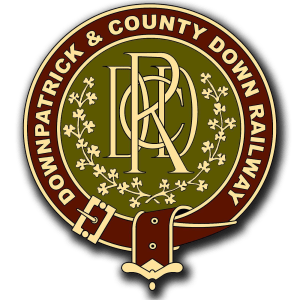
The Chandelier Room in the Slieve Donard Hotel
Smart suits and fancy frocks, not a phrase you often associate with the volunteers of the Downpatrick & County Down Railway, who are more often to be found covered in various shades of grease, smoke and dirt underneath carriages or engines…
But last Friday the volunteers let down their hair and dolled up in the culmination of the celebrations of the 150th Anniversary of the railway opening to Downpatrick, and the 140th of its opening to Newcastle, with a gala dinner in the Slieve Donard Hotel.
The Slieve Donard Hotel was chosen as the venue as it was originally owned and run by the Belfast & County Down Railway. The event was held in an original room of the hotel, the Chandelier Room, which looked suitably impressive, with lit candelabras adorning each table, a fire in the fireplace and views out the bay over the sea and Newcastle. The old crest of the BCDR dominated the room as guests entered.
Over seventy guests attended the function (an increase from the original 60 the room was booked for) ranging from volunteers and family, to many non-volunteer society members, veterans and family of the old Belfast and County Down Railway, councillors and officials from Down District Council, and special guests such as Dr. Billy Hastings, local MP Eddie McGrady, and renowned historical author on all things ‘County Down’, Desmond Coakham.
The night began with a four-course meal, consisting of a Honeydew Melon starter, cream of celery soup, and the main course of Chicken Isobel, followed by apple pie. The printed menus incorporated the old historic emblem of the hotel when it was owned by the BCDR, which proved quite popular with souvenir collectors.
After the meal the guests were welcomed by Robert Gardiner of the DCDR to this anniversary function. Mr. Gardiner paid thanks to Dr. Hastings and Mr. John Toner of Hastings Hotels for enthusiastically backing the anniversary celebrations, and what better place for such a celebration than in the ‘Jewel in the Crown’ of the old BCDR railway – the Slieve Donard Hotel. He also noted that he was particularly pleased to see so many people who either worked on the old BCDR or had a family connection to the line.
Mr. Gardiner then welcomed Colin McGrath, chairman of Down District Council, to say a few words. Mr. McGrath was pleased to welcome all the guests to this part of the district, and to celebrate such a milestone in the railway history of the town. He remarked that it was in not too many towns or cities across Northern Ireland where they had lost their railway links around the same period that south Down lost its links, that such a celebration could occur, and that this was down to the hard work of the volunteers of the Downpatrick & County Down Railway, who take their name in honour of the old company, that this could happen. He said that everyone who was involved in volunteering across the District was in awe of what was being done in the town by the railway, and that the Council looked forward to seeing and supporting that rich railway legacy continuing and growing in the future.
Mr. Gardiner then took guests through a timeline of how the line to Downpatrick was built and why. He revealed that it was not an easy birth, that the disastrous impact of the famine on the country delayed construction for nearly a decade, and that even when it was close to being built, it faced competition from rivals wanting to built a line between Lisburn and Downpatrick.
But built it was, and he concluded his presentation by reading an extract from the official minutes of the BCDR in 1859, where the chairman William R. Anketell from Ballynahinch, announced the line to be open, and paid tribute to the work involved and his hopes for the profitability of the line. Mr. Gardiner noted that it wouldn’t last, and that crippled by the Second World War, the BCDR nearly collapsed as a company, and had to be saved by the Stormont government. It was a situation which led to the closure of all the BCDR lines except the Bangor line.
Passing over to current DCDR chairman Michael Collins, who observed that was where many people thought the rail legacy would end. But Mr. Collins showed the audience via a slideshow, the very beginnings of the current heritage railway scheme, and how it started with virtually a blank canvass, with everything having been ripped up in the mid-1950s, and how many people thought this scheme would never get off the ground.
Taking the audience through the various milestones since the 1980s, Mr. Collins concluded with some of the ideas the DCDR has for the future, as a tantalising glimpse of railway legacy yet to come.
Mr. Gardiner returned to the podium again and played for the audience ‘as a treat’ some rare black and white, as well as colour footage of the last trains on the BCDR before closure. There were gasps from the audience, bringing back memories for those who worked on the lines, and a glimpse back for many of audience who had never seen a BCDR train in motion either in real life or on screen, or had only seen still images.
Thanking everyone for attending, he said that if the DCDR could preserve even a portion of that railway legacy, then it was a job well done. And with thunderous applause, the night concluded
